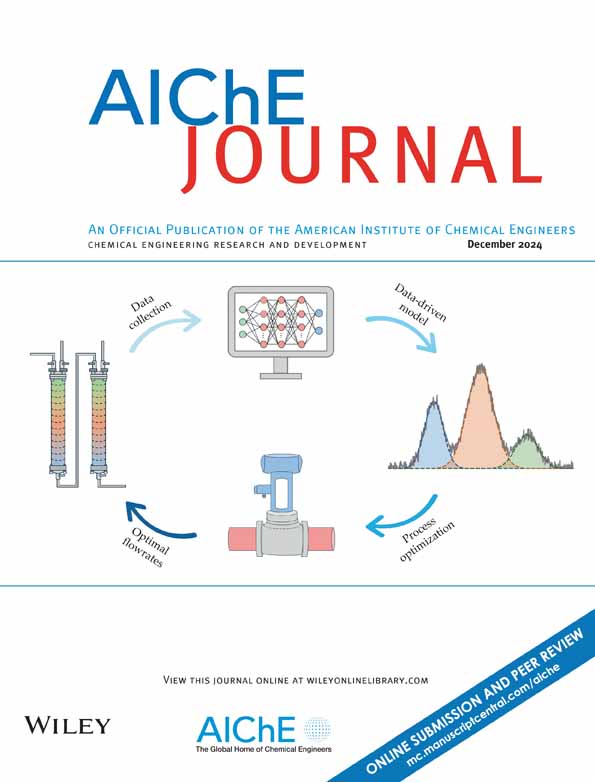100% CO2选择性Fe2O3/Fe3O4氧化还原对Ba‐六铁体通过接力供氧捕获CO2
IF 4
3区 工程技术
Q2 ENGINEERING, CHEMICAL
引用次数: 0
摘要
设计一种具有高氧传输能力(Ot)的铁基氧载体,在不降低二氧化碳选择性和可回收性的情况下,超过Fe2O3/Fe3O4氧化还原对,仍然是通过化学环燃烧(CLC)技术捕获二氧化碳的重大障碍。在此,我们提出了一种新颖的策略,将铁阳离子限制在BaFe12O19六铁体基质中,该基质具有3.0 mmol/g的优异Ot和100%的CO2选择性(超过纯Fe2O3→Fe3O4的最大极限2.08 mmol/g),并且在50个氧化还原循环中具有独特的Ot增加趋势,具有良好的可回收性,这与大多数报道的铁基OCs不同。高氧化度和可回收性与“接力供氧”密切相关,包括Ba‐六铁体中反射面优先扩散路线和纳米Ba‐修饰Fe3O4/FeO的原位形成。循环氧化还原处理使更多的Ba2+转化为Fe氧化物,并使Ba2+表面富集,从而在后期的氧化还原循环中保证了高的可回收性和增加的Ot。本文章由计算机程序翻译,如有差异,请以英文原文为准。
100% CO2 selectivity Fe2O3/Fe3O4 redox pair of Ba‐hexaferrite for CO2 capture via relay oxygen donation
Engineering an iron‐based oxygen carrier with high oxygen transport capacity (Ot ) surpassing Fe2 O3 /Fe3 O4 redox pair without decreasing CO2 selectivity and recyclability remains a substantial obstacle for CO2 capture via chemical looping combustion (CLC) technology. Herein, we propose a novel strategy by confining iron‐cations into the matrix of BaFe12 O19 hexaferrite, which exhibited both superior Ot of 3.0 mmol/g with 100% CO2 selectivity (exceeding the maximal limit of 2.08 mmol/g for pure Fe2 O3 → Fe3 O4 ), and a unique increased trend in Ot with good recyclability during 50 redox cycles, different from most reported Fe‐based OCs. The high Ot and recyclability were closely related to the “relay oxygen supply” involving the preferential diffusion route of the mirror plane in Ba‐hexaferrite and in situ formation of nanosized Ba‐modified Fe3 O4 /FeO. The cyclic redox treatment induced more Ba2+ into Fe oxides and the surface enrichment of Ba2+ , thus ensuring high recyclability with increased Ot during the later redox cycles.
求助全文
通过发布文献求助,成功后即可免费获取论文全文。
去求助
来源期刊

AIChE Journal
工程技术-工程:化工
CiteScore
7.10
自引率
10.80%
发文量
411
审稿时长
3.6 months
期刊介绍:
The AIChE Journal is the premier research monthly in chemical engineering and related fields. This peer-reviewed and broad-based journal reports on the most important and latest technological advances in core areas of chemical engineering as well as in other relevant engineering disciplines. To keep abreast with the progressive outlook of the profession, the Journal has been expanding the scope of its editorial contents to include such fast developing areas as biotechnology, electrochemical engineering, and environmental engineering.
The AIChE Journal is indeed the global communications vehicle for the world-renowned researchers to exchange top-notch research findings with one another. Subscribing to the AIChE Journal is like having immediate access to nine topical journals in the field.
Articles are categorized according to the following topical areas:
Biomolecular Engineering, Bioengineering, Biochemicals, Biofuels, and Food
Inorganic Materials: Synthesis and Processing
Particle Technology and Fluidization
Process Systems Engineering
Reaction Engineering, Kinetics and Catalysis
Separations: Materials, Devices and Processes
Soft Materials: Synthesis, Processing and Products
Thermodynamics and Molecular-Scale Phenomena
Transport Phenomena and Fluid Mechanics.
 求助内容:
求助内容: 应助结果提醒方式:
应助结果提醒方式:


